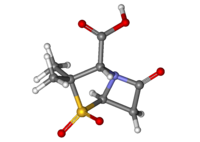Sulbactam
 |
|
 |
|
| Clinical data | |
|---|---|
| AHFS/Drugs.com | International Drug Names |
| MedlinePlus | a693021 |
| Routes of administration |
Injection |
| ATC code | J01CG01 (WHO) |
| Legal status | |
| Legal status |
|
| Pharmacokinetic data | |
| Bioavailability | 1 |
| Excretion | Kidneys? |
| Identifiers | |
|
|
| CAS Number |
68373-14-8 |
| PubChem (CID) | 130313 |
| ChemSpider |
115306 |
| UNII |
S4TF6I2330 |
| KEGG |
D08533 |
| ChEBI |
CHEBI:9321 |
| ChEMBL |
CHEMBL403 |
| ECHA InfoCard | 100.063.506 |
| Chemical and physical data | |
| Formula | C8H11NO5S |
| Molar mass | 233.243 g/mol |
| 3D model (Jmol) | Interactive image |
|
|
|
|
Sulbactam is a β-lactamase inhibitor. This drug is given in combination with β-lactam antibiotics to inhibit β-lactamase, an enzyme produced by bacteria that destroys the antibiotics.
Sulbactam is an irreversible inhibitor of β-lactamase; it binds to the enzyme and does not allow it to degrade the antibiotic.
Sulbactam is able to inhibit the most common forms of β-lactamase but is not able to interact with the AmpC cephalosporinase. Thus, it confers little protection against bacteria such as Pseudomonas aeruginosa, Citrobacter, Enterobacter, and Serratia, which often express this gene.
In the United States, sulbactam is combined to form cefoperazone/sulbactam and ampicillin/sulbactam. It does possess some antibacterial activity when administered alone, but it is too weak to have any clinical importance. Its use in the UK is restricted to hospitals.
Recently, its use in treating Acinetobacter septicemia is receiving renewed interest.
...
Wikipedia
